Imagine this: two men–father and son–both of whom spent their lives creating exquisite cemetery memorials—who have no cemetery monument marking their own graves.
It happens.
Green-Wood has many spectacular monuments. Perhaps the best: the monument to Jane Griffith.
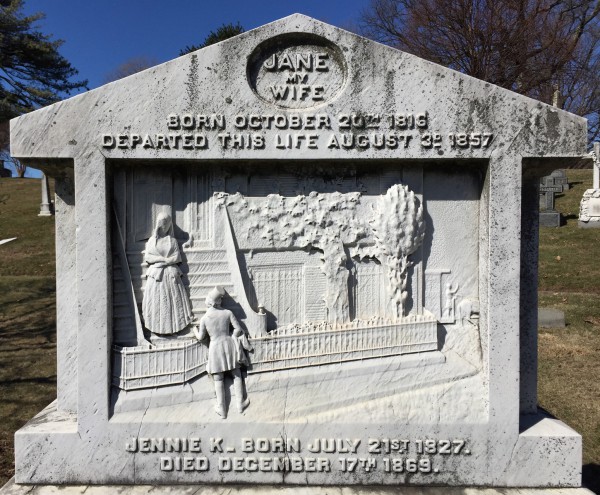
The Griffith Monument has a touching back story. Erected to “Jane, My Wife,” it memorializes Jane Griffith (1816-1857)–just 41 years old when she died. She was not famous, but was much loved by her husband Charles. On the morning of August 3, 1857, in a typical domestic scene of the time, she stood on the steps of their wisteria-covered brownstone at 109 West 13th Street in Manhattan, with a cast iron fence marking their lot, dog at her side, bidding her husband goodbye as he headed off to the waiting Sixth Avenue horsecar that would take him downtown to work. Sadly, when Charles returned home that evening, he found Jane dead of a heart attack.
Way back when, in about 1997, I was researching and writing the book, Brooklyn’s Green-Wood Cemetery: New York’s Buried Treasure. As I worked on the book, and visited the Griffith Monument, I was able to detect what appeared to be a sculptor’s signature on it. But there was one big problem—no matter how long I stared at that signature, I could not make it out.

That mystery was solved when I came across Meyer Berger’s New York: A Great Reporter’s Record of his Love Affair with a City. Berger was a Pulitzer Prize-winning reporter for The New York Times. In his December 3, 1954 column, reproduced in that book, he wrote about his visit to the Jane Griffith Monument: “Tom Manning, the supervisor today, says that Charles Griffith assigned P. Piatti, a sculptor, to study the house, a photograph of Mrs. Griffith, and himself, the better to arrest forever the moment when Mr. Griffith saw his wife for the last time. It was the morning of Aug. 3, 1857, when the horse-trolley waited.”
Who was this “P. Piatti?” I went up to the New-York Historical Society to check New York City directories for the 1850s. Lo and behold, I found a listing for a sculptor named Patrizio Piatti–who advertised that he “designed and executed to order” monuments, headstones, and mantel pieces “in the purest professional styles of the different ages of art.” That was the sculptor of the Griffith Monument!
Born near Milan, Italy, Patrizio Piatti (1827-1888) was from a family of generation after generation of marble sculptors. According to his obituary in The New York Times, he was “a warm friend” of the Italian patriot Garibaldi. Piatti came to New York about 1850, after having taken part in the Revolution of 1848, and established himself as a sculptor in marble of cemetery monuments and fireplace mantles. In the 1877 New York City Directory, he is listed as a sculptor at 259 West 14th Street. The 1880 census lists him as a sculptor living with his wife Antonia and their three children, Emilio, Virgilio, and Virgil. Antonia was born in Italy; their three children were born in New York. Though I have been unable to find a portrait of him, we do have a detailed description of what he looked like: according to his 1871 passport application, Piatti was 5’7” with a high forehead, dark eyes, medium nose, medium mouth, grey hair, robust complexion and oval face. He was a founder of La Societa Italiana di Frateilanza, the first Italian society in the United States. Piatti also sculpted the marble interior of very ostentatious A.T. Stewart’s Mansion at 34th Street and Fifth Avenue in Manhattan. On July 21, 1888, he was found dead in his bed, having accidentally suffocated from a gas leak.
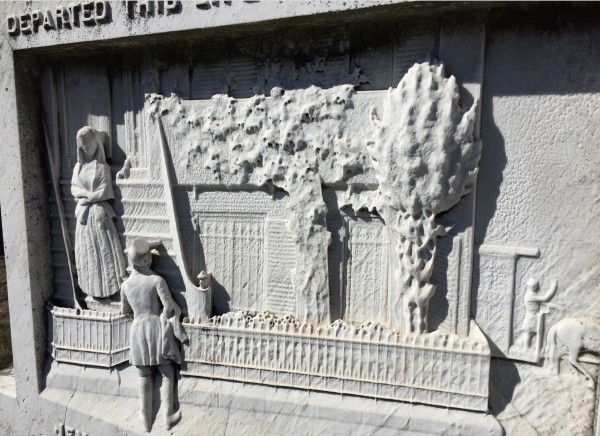
The American Magazine for January-June, 1888, lauded Patrizio Piatti: “His work is marked by a delicate touch, and should his plaster model be imperfect as to drapery or outline, he is sure to see that the original is vastly improved under his skillful cutting. Some of the most remarkable busts and medallions have come from his chisel . . . .”
Discovery of the Berger article made it possible for us to identify Patrizio Piatti as the sculptor of the Griffith Monument. And Piatti’s obituary in the Times adds more information about his work at Green-Wood: “Among the important works of which Mr. Piatti was the sculptor was the monument to Col. Vosburgh of the Seventy-first Regiment, the Sea Captain’s Monument, and the Griffith Memorial, all in Greenwood Cemetery.” These are, beyond doubt, three of the finest examples of marble sculpture at Green-Wood.
Sea Captain John Correja (1826-1910) loved Green-Wood’s peace and quiet. For the last half century of his life, he brought friends to his cemetery lot, overlooking Cedar Dell, for picnics. When he wasn’t sailing the oceans, he could be seen in his Green-Wood lot, absorbed in a book. Late in the 1850s, Correja purchased Carrara marble in Italy–the finest of stones–and brought them back on his ship for Patrizio Piatti to carve into a life-size portrait of Correja.
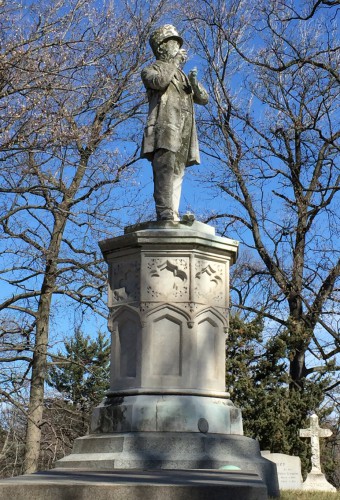
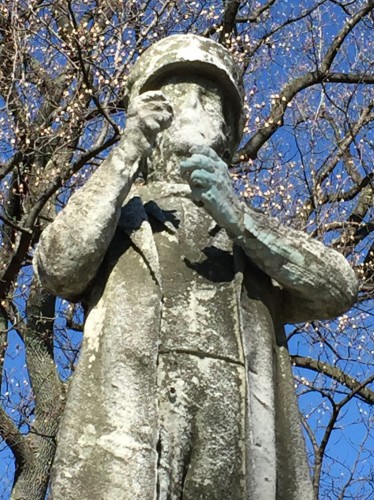
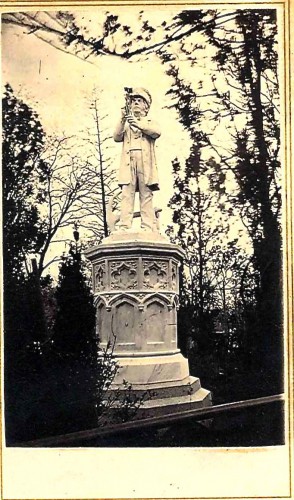
On April 22, 1861, Colonel Abraham S. Vosburgh (1825-1861) marched at the head of the 71st New York Militia as it hurried off to Washington, D.C., in response to President Abraham Lincoln’s urgent call for troops to defend the nation’s capital against Confederate attack. Sadly, within weeks, Vosburgh was dead of consumption. Lincoln laid a wreath on Vosburgh’s casket and it was sent off back to Brooklyn. This hymn was sung by the troops of the 71st at Colonel Vosburgh’s funeral:
Hush! Our colonel lies in slumber,
Folded close in death’s cold arms;
Never more he’ll join our numbers,
Never more hear war’s alarms.
Frank by nature, brave and loyal–
Dearly loved and prized was he;
Now his wreath is more than royal–
In our hearts enshrined he’ll be.
Never more the drums swift beating,
Nor the clarion trumpet shrill,
Shall arouse him from his sleeping,
And his breast with ardor fill.
He was loved by all his brothers
In the camp – none more than he;
Everything he shared with others,
Now we claim his memory.
And the Seventy-first will cherish
All his virtues, all his aims.
If in battle we shall perish,
Doing what stern duties claim,
He will gaze with satisfaction,
Smiling as he used to smile,
To regard our noble action,
And be proud of us the while.
Wrap our glorious Flag about him,
Let the stripes and stars be seen,
Whilst his comrades who surround him,
Swear to keep his memory green;
Then will his proud soul elate him
Higher still to camps above,
Where the angel warriors ‘wait him,
And a sword of perfect love.
Vosburgh was interred at Green-Wood in section 123, lot 13808, near Brooklyn’s highest point, with spectacular views of Battle Hill and New York Harbor. Several years later, his comrades collected $5,000 and hired Patrizio Piatti to sculpt a marble monument to him at Green-Wood. The New York Times of May 24, 1866, reported on the ceremony to unveil the memorial:
. . . The formal inauguration of the monument erected by the 71st Regiment to the memory of Col. Abraham S. Vosburgh, took place yesterday afternoon at Greenwood Cemetery. The ceremonies attendant upon the occasion were imposing in their character, embracing the burial of the remains of the deceased and lamented Colonel, a military salute over the grave and an address by Mayor [John] Hoffman [of New York City], upon the life and services of the man whose memory the monument was intended to perpetuate . . . .
Topped by an eagle and bearing the inscription “Pro Patria” (for country), this monument was one of the leading tourist attractions at Green-Wood in the 19th century. It was surrounded by a spectacular cast iron fence, the posts of which were shaped as bayoneted rifles. Its gate was adorned with a cast iron Union cap, a belt, and a sword. For years after Vosburgh’s burial, members of the 71st fired three salutes to their fallen colonel on every Decoration Day.
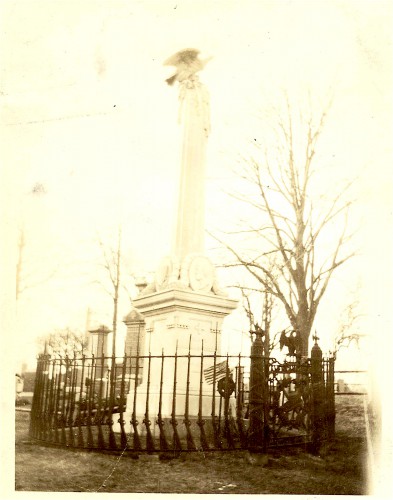
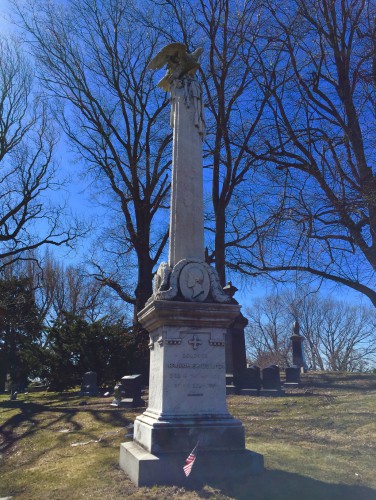
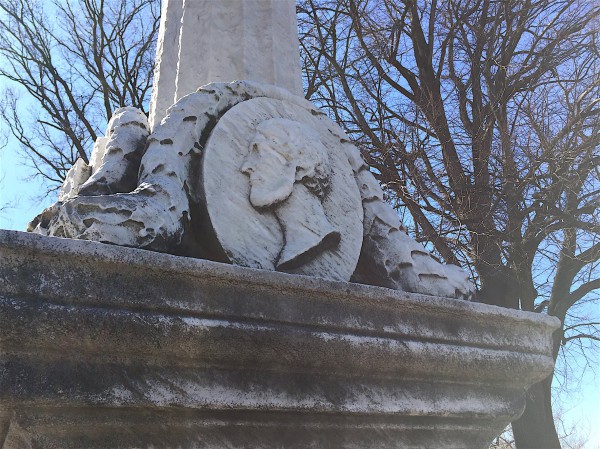
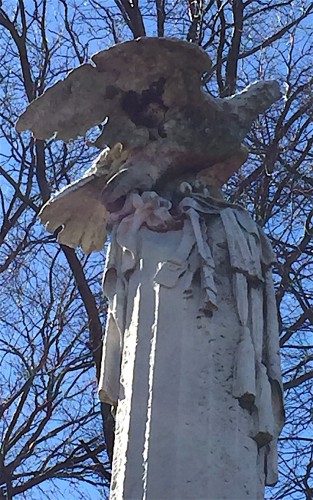
Born in New York City, where his father was a sculptor, Emilio F. Piatti (1859-1909) apprenticed to his father and carried on the multi-generational profession—marble carvers–of the Piatti family. Though there is little information about Emilio otherwise available, a letter that he wrote in 1902, now at The Metropolitan Museum, describes his career in detail. As he reports, he graduated from New York College and Cooper Union, then studied sculpture with his father and with his uncle in Milan, Italy. He assisted sculptor Caspar Buberl on the James Garfield Memorial in Lakeview Cemetery (Cleveland, Ohio), the Soldiers Arch in Hartford, Connecticut, and panels for the Patent Office in Washington, D.C. He also sculpted marble panels and portraits for sculptor Augustus Saint-Gaudens. Emilio sculpted the bronze life-size statue next to the Ludin sarcophagus at Green-Wood, as well as several Civil War soldier monuments, including those at Saratoga, New York, Lincoln, Rhode Island, and Minneapolis, Minnesota.
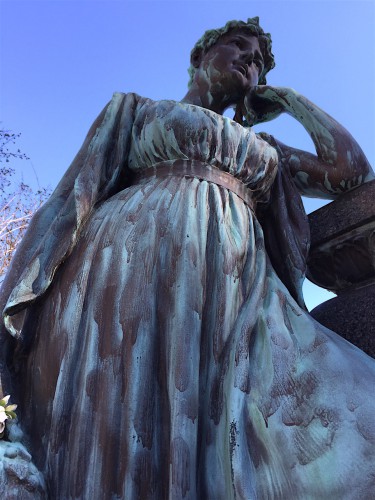
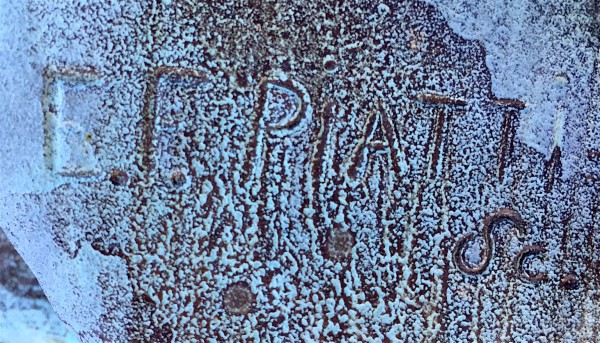
Emilio Piatti sculpted monuments across America. His Soldiers Monument in Greenwich, Connecticut, dates from 1890:
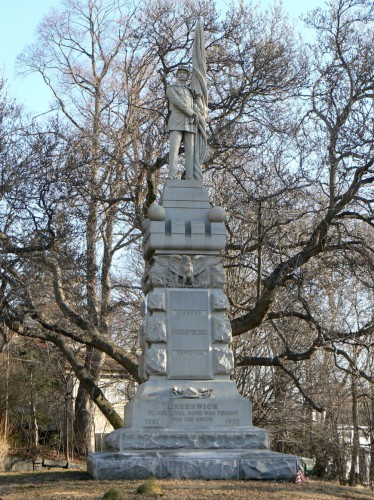
Amazingly, both Patrizio Piatto and Emilio F. Piatti, who skillfully sculpted monuments for others at Green-Wood and in other cemeteries, themselves lie in unmarked graves at Green-Wood. This is the only marker in the Piatti family lot:
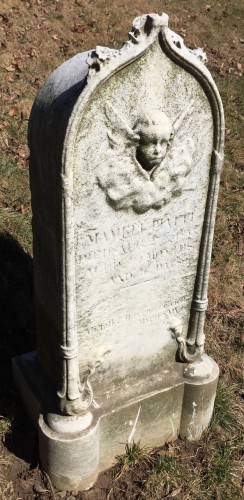
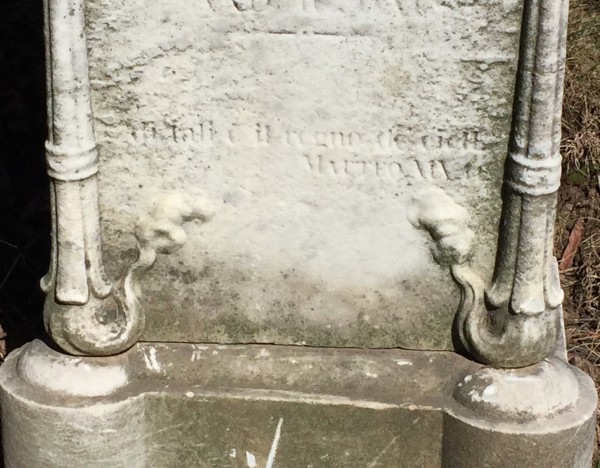
Green-Wood is about to launch a program to mark the graves of interesting individuals interred at Green-Wood who have no monuments. The graves of both Piattis–sculptors who adorned Green-Wood, other cemeteries, and public spaces, but not their own graves–will soon be marked with memorials to them.